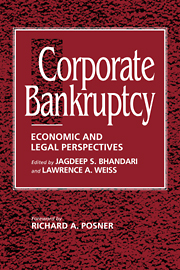Book contents
- Frontmatter
- Contents
- List of tables and figures
- Foreword by the HONORABLE RICHARD A. POSNER
- Preface
- Part I The role of credit
- Part II Bankruptcy as a reflection of the creditors' implicit bargain
- 4 A world without bankruptcy
- 5 Bankruptcy, nonbankruptcy entitlements, and the creditors' bargain
- 6 Translating assets and liabilities to the bankruptcy forum
- 7 Bankruptcy policy
- 8 Loss distribution, forum shopping, and bankruptcy: A reply to Warren
- Part III Beyond the basic creditors' bargain
- Part IV Workouts or bargaining in the shadow of bankruptcy
- Part V Alternatives to bankruptcy and the creditors' bargain
- Part VI Experience of other countries
- Index
6 - Translating assets and liabilities to the bankruptcy forum
Published online by Cambridge University Press: 10 December 2009
- Frontmatter
- Contents
- List of tables and figures
- Foreword by the HONORABLE RICHARD A. POSNER
- Preface
- Part I The role of credit
- Part II Bankruptcy as a reflection of the creditors' implicit bargain
- 4 A world without bankruptcy
- 5 Bankruptcy, nonbankruptcy entitlements, and the creditors' bargain
- 6 Translating assets and liabilities to the bankruptcy forum
- 7 Bankruptcy policy
- 8 Loss distribution, forum shopping, and bankruptcy: A reply to Warren
- Part III Beyond the basic creditors' bargain
- Part IV Workouts or bargaining in the shadow of bankruptcy
- Part V Alternatives to bankruptcy and the creditors' bargain
- Part VI Experience of other countries
- Index
Summary
A bankruptcy system sorts out rights among claimants to particular assets. But this sorting does not exist in the abstract; rather, it is derived from activities in the nonbankruptcy world that create myriad relationships among various entities. These relationships give rise to a rich variety of substantive entitlements (assets) and obligations (liabilities). These assets and liabilities, as well as their implementation, may vary in subtle (or not so subtle) ways one from another, both because of various private arrangements and because of the dictates of legal rules. The ways in which implementing them may vary, moreover, differ depending on whether the question is being addressed as one, say, of debtor versus creditor or as one of creditor versus creditor.
All this richness affects the bankruptcy process. Bankruptcy's central normative goal is to collectivize the process by which a debtor's assets are made available to its claimants. This goal can be achieved only if the nonbankruptcy attributes of assets and liabilities that affect ordering among claimants are identified and translated precisely, with minimal dislocations, into the bankruptcy forum. Questions of identification and translation are difficult. Nonetheless, it is rarely necessary to compound this difficulty by asserting the relevance of any bankruptcy policy other than those inherent in (or implied by) the collectivization norm.
The Normative Role of a Bankruptcy Proceeding
Introduction
The need for bankruptcy arises from the operations of the nonbankruptcy world.
- Type
- Chapter
- Information
- Corporate BankruptcyEconomic and Legal Perspectives, pp. 58 - 72Publisher: Cambridge University PressPrint publication year: 1996



